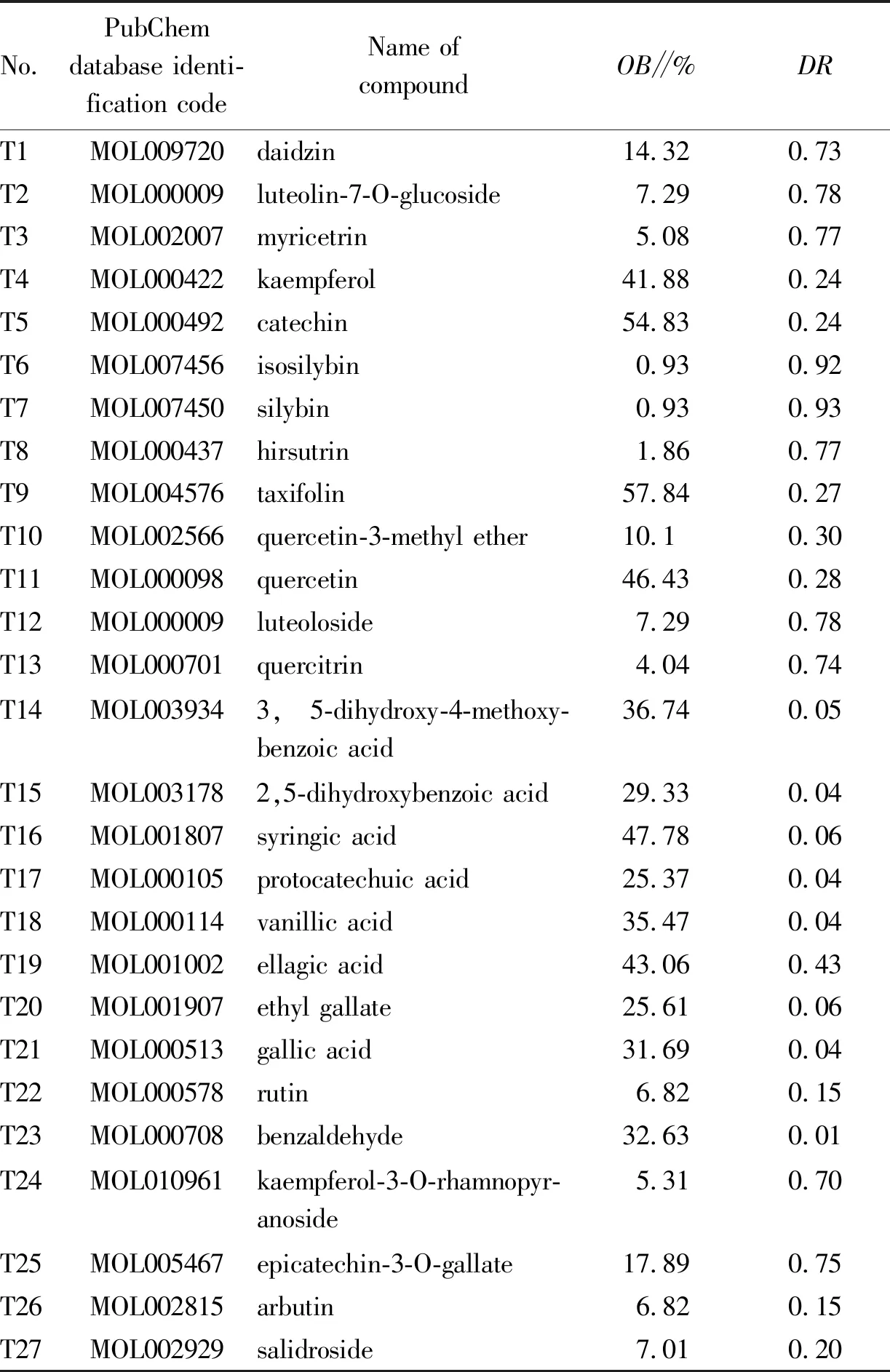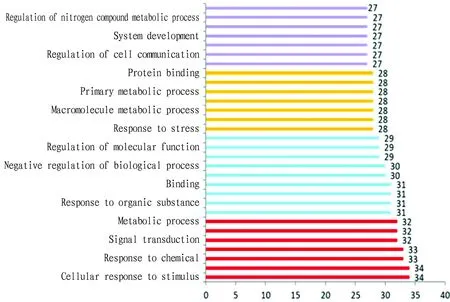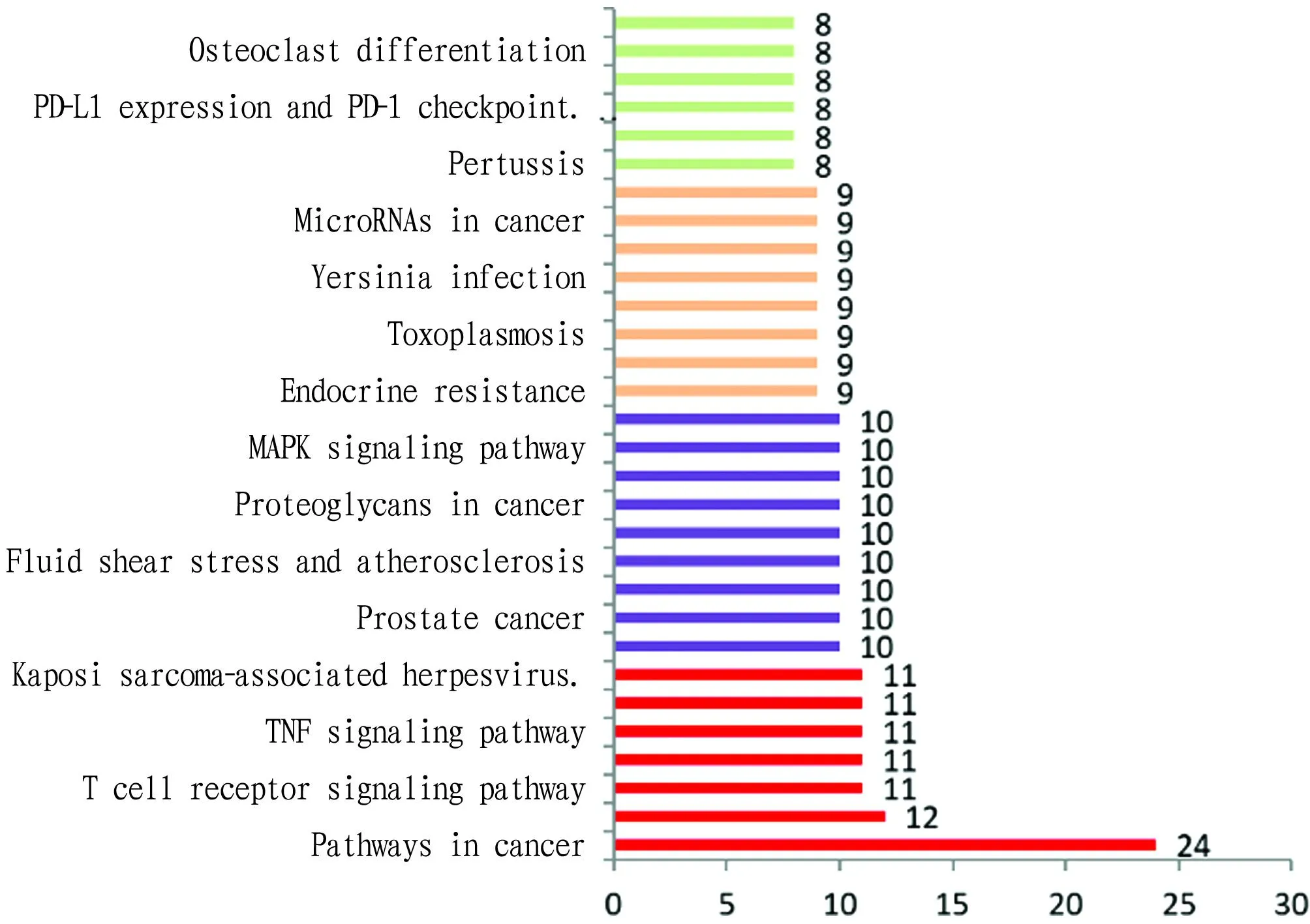Investigation on the Material Basis of Sijicao Granules in Treating Eczema Based on Network Pharmacology
Yitong SHEN, Bo TU, Yaru YANG, Li JIANG, Minghui HE, Yan LIN*
1. School of Pharmaceutical Sciences, Guizhou Medical University, Guiyang 550025, China; 2. University Engineering Research Center for the Prevention and Treatment of Chronic Diseases by Authentic Medicinal Materials in Guizhou Province, Guiyang 550025, China
Abstract [Objectives] To explore the pharmacodynamic material basis of Sijicao granules for the treatment of eczema through chemical composition-network pharmacology. [Methods] First of all, the chemical constituents of Polygonum capitatum and Plantago asiatica from Sijicao granules were collected, and the relevant target information of the constituents was collected by TCMSP, PubChem, DisGeNET, GeneCards and STRING databases. Furthermore, Cytoscape 3.8.2 software was used to construct the chemical compounds-target network map of Sijicao granules. Finally, STRING database was used for PPI protein network analysis, GO functional enrichment analysis and KEGG pathway enrichment analysis of core targets, and molecular docking between core constituents and protein targets was also performed. [Results] 30 constituents, including quercetin, kaempferol, luteolin, ellagic acid and gallic acid, were discovered to be the key effective compounds of Sijicao granules in the treatment of eczema. And its core action protein targets were PTGS2, NOS2, AKT1, TP53, IL6, HMOX1. What’s more, through GO functional enrichment analysis of biological process (BP), cell component (CC), molecular function (MF) analysis and KEGG pathway enrichment analysis, the main pathways of action of Sijicao granules for the treatment of eczema including IL-17 signaling pathway, T cell receptor signaling pathway, cancer signaling pathway, TNF signaling pathway and Relaxin signaling pathway. In addition, molecular docking results displayed that the primary active constituents quercetin, kaempferol and luteolin were well combined with the core protein targets AKT1 and IL6. [Conclusions] Sijicao granules could play an important role for the treatment of eczema through multi-component, multi-target, multi-pathway and their interaction.
Key words Sijicao granules, Network pharmacology, Eczema, Polygonum capitatum, Plantago asiatica L., Molecular docking
1 Introduction
Eczema, a common dermatological disease, is mainly caused by a variety of internal and external factors with obvious exudation tendency of skin inflammation, which has various forms. Itching is severe during the attack, and it is prone to relapse and difficult to cure, which seriously affects people’s quality of life[1]. At present, corticosteroids, histamine antagonists and vitamins are commonly used in the topical treatment of eczema. Compared with these hormone preparations, Chinese medicine and its traditional Chinese medicine preparations show less adverse drug reactions and toxic side effects, better therapeutic effect, and have no effect on pregnant women and lactating women[2]. It has been reported that the flowers and roots of some medicinal plants contain effective constituents that can repair, smooth and protect skin, and effectively improve eczema symptoms[3]. At present, there are a wide range of traditional Chinese medicine compound preparations for eczema treatment in clinic, such as compound Qinbai granules for fumigation, hip bath and pine pollen treatment[4], compound flumethasone soft capsules, compound triamcinolone acetonide cream[5]and Longdan Xiegan Decoction treatment[6].
Sijicao granules (also known as Tonglinshu granules) are traditional Chinese medicine granules extracted fromPolygonumcapitatumandP.asiaticaL. in Guizhou Province, mainly having the pharmacological effects of clearing away heat and toxic materials, diuresis and relieving stranguria. They are commonly used to treat dysuria, short and red urine, chronic prostatitis, prostatic hyperplasia and other diseases in clinic[7-8]. According to the literature investigation on the chemical constituents ofP.capitatumandP.asiaticaL.,P.capitatummainly contains flavonoids, phenolic acids, lignans and other chemical constituents, whileP.asiaticaL. mainly contains flavonoids, triterpenes, polyphenols and alkaloids[9-10]. Pharmacological activity studies show thatP.asiaticaL. andP.capitatumhave significant anti-inflammatory, antibacterial, anti-tumor and antioxidant activity[11-13]. In particular, quercetin, a flavonoid fromP.capitatum, shows significant pharmacological activity such as anti-inflammatory, antibacterial and anticancer effects[14-15]. In addition, it has been reported that Sijicao granule has alleviating effect on eczema, but its material basis, action pathway and action target have not been reported, which seriously limits its quality control and deep development and application.
The mechanism of "multi-component—multi-target—multi-pathway" in network pharmacology has unique advantages in analyzing various complex diseases, especially the research methods for analyzing traditional Chinese medicine compounds are gradually widely used[16-17]. To sum up, this paper used network pharmacological analysis to predict the effective constituents, action pathways and action targets of Sijicao granules in treating eczema, which provides a theoretical basis for the study of material basis and action mechanism of Sijicao granules in treating eczema.
2 Materials and methods
2.1 MaterialsTCMSP database (http://lsp.nwu.edu.cn/tcmsp.php), DisGeNET database (http://www.disgenet.org/), GeneCards database (https://www.genecards.org/), STRING database (https://string-db.org/), Cytoscape 3.8.2 software (http://www.cytoscape.org), PDB database (http://www.rcsb.org), Chem3D software, PubChem database (https://pubchem.ncbi.nlm.nih.gov), Pymol software,etc.
2.2 Methods
2.2.1Screening of chemical constituents and acquisition of active constituents. The chemical constituents ofP.capitatumandP.asiaticaL. in Sijicao granules used in this experiment come from the previous research of this experimental subject and related literature reports. By TCMSP database and PubChem database, the active constituents ofP.capitatumandPlantagoasiaticaL. were collected and screened. The action targets of active constituents ofP.capitatumandP.asiaticaL. were obtained from TCMSP and PubChem databases, and the target proteins collected from the two databases were combined respectively, and the duplicate proteins were removed.
2.2.2Acquisition of eczema disease targets. Through DisGeNET database and GeneCards database, eczema-related targets were collected with "eczema" as the key word.
2.2.3Transformation of related targets. The obtained active constituent target and disease target were imported into STRING respectively, and the species was limited to human, so as to transform into human genes.
2.2.4Construction of network map of active constituents and targets related to eczema diseases. The collected active constituents of Sijicao granules and eczema disease targets were screened by Venn diagram, and the common targets were obtained. The selected active constituents and common targets were imported into Cytoscape 3.8.2 software, and the chemical composition-target network diagram was established. Then topological analysis was used to sort the data according to the degree value, and the compounds and targets with high correlation degree were selected for subsequent experimental analysis.
2.2.5Construction of PPI network of interaction between Sijicao granules and eczema targets. The common proteins of chemical constituents and disease-related proteins were taken, that is, the common targets of chemical constituents of Sijicao granules in treating eczema. STRING database was used to analyze the interaction between proteins.
2.2.6Gene function enrichment and molecular docking. GO analysis and KEGG analysis were performed on the core targets of Sijicao granules by STRING database. AutoDock Tools and other software were used for molecular docking between core protein and main pharmaceutical chemical constituents.
3 Results and analysis
3.1 Screening results of chemical constituentsAccording to the previous research of the experimental research group and the analysis of related literature reports, 70 compounds were collected fromP.asiaticaL., among which 10 compounds were finally obtained according to ADME (oral bioavailabilityOB≥30%, drug resistanceDR≥0.18) (Table 1).

Table 1 Chemical constituents of Plantago asiatica L.
According to the previous research and related literature reports, 27 compounds were collected fromP.capitatum(Table 2).

Table 2 Chemical constituents of Polygonum capitatum
3.1.1Acquisition results of active constituents. 10 and 27 chemical constituents were collected fromP.asiaticaL. andP.capitatum, 109 and 186 targets were obtained respectively after removing duplicates by TCMSP and PubChem databases. The gene was transformed into human gene by STRING database, and 144 and 459 targets were obtained respectively after removing duplicates.
3.1.2Acquisition of eczema disease targets. A total of 3 727 eczema targets were collected by DisGeNET database and GeneCards database with "eczema" as the key word, and 2 660 corresponding targets were obtained by transforming them into human genes via STRING.
3.1.3Construction of Venn diagram of Sijicao granules-eczema target. Draw Venn Diagram (http://bioinformatics.psb.ugent.be/webtools/Venn/) was used to make Venn diagram of chemical composition and disease-related targets, and the intersection genes were determined. As shown in Fig.1, it can be seen that there were 43 common targets of Sijicao granules and eczema diseases, and 31 targets ofP.capitatumandP.asiaticaL.

Note: T. Polygonum capitatum; C. Plantago asiatica L.; J. Eczema disease; the purple circle represents the P. capitatum target, pink circle represents the P. asiatica L. target and green circle represents the disease target.
3.1.4Construction of "component-target" interaction network of Sijicao granules. The component targets collected from TCMSP and PubChem databases were sorted out, and the compounds with no corresponding targets detected were removed, thus obtaining 8 potential pharmacodynamic substances ofP.asiaticaL. alkaloids and 26 potential pharmacodynamic substances ofP.capitatum; the target data related to eczema collected from DisGeNET database and GeneCards database were imported into Cytoscape 3.8.2 software to establish an "active constituent-target" network diagram, and the results are shown in Fig.2. The constituent-target interaction network diagram had 526 nodes and 1 622 connection paths[18]. The average connectivity of the network was 6.167, and the median was 1. Therefore, the nodes with connectivity greater than or equal to 4 were determined as the hub nodes of the network. A total of 71 hub nodes were obtained in the target network, having greater influence and playing a more important role in the network[18].

Note: Green circle represents the active constituents of P. capitatum, as shown in Table 2; red circle represents the active constituents of P. asiatica L., as shown in Table 1; the blue triangle symbol indicates the target of eczema disease; the darker the color, the larger the figure, the stronger the interaction between the constituent and the target protein.
3.1.5Construction of PPI protein target network. 144 targets corresponding toP.asiaticaL. constituents, 459 targets corresponding toP.capitatumconstituents and 2 660 eczema targets were combined to screen out common targets, and PPI protein interaction network analysis was carried out by STRING database. Cytoscape 3.8.2 software was used to establish the interaction network diagram between targets. As shown in Fig.3, the PPI network diagram of common targets was drawn with moderate reliability (>0.400), and the PPI enrichment difference was statistically significant (P<1.0e-16). The data were imported into Cytoscape 3.8.2 software to make a network diagram (Fig.4), and the connectivity of targets was obtained by topological analysis, with an average connectivity of 38.98 and a median of 40. The targets with connectivity greater than 20 were selected as the core targets of Sijicao granules alkaloids in the treatment of eczema.

Fig.3 Protein-protein interaction network of common targets

Fig.4 PPI network of common targets
3.1.6Construction of "drug-component-target-disease" network. 30 potentially effective chemical constituents of Sijicao granules were obtained by removing compounds with no corresponding targets detected fromP.capitatumandP.asiaticaL. respectively, and then imported into Cytoscape 3.8.2 with the above 34 core targets to make a network diagram of the connection relationship betweenP.capitatumandP.asiaticaL. constituents, core targets and disease eczema (Fig.5).

Fig.5 Drug-constituent-target-disease network
3.1.7Analysis results of functional enrichment of GO and KEGG. GO analysis and KEGG function enrichment analysis of core targets were carried out by STRING database. According to the observed gene count value from small to large, the first 30 with the largest number of targets were selected for visual analysis, and finally presented in the form of histogram. The potential active constituents of Sijicao granules in the treatment of eczema were obtained, and the results of GO functional enrichment analysis and KEGG functional enrichment analysis were shown in Fig.6 and 7, and the "drug-constituent-target-disease-pathway" network diagram of Sijicao granules was constructed, as shown in Fig.8.

Fig.6 GO enrichment analysis of Sijicao granules in treating eczema

Fig.7 KEGG enrichment pathway analysis of Sijicao granules in treating eczema

Fig.8 Drug-constituent-target-disease-pathway
3.2 Molecular docking analysisChemBio3D and PyMOL were used to pretreat the main constituents in order to further explore the therapeutic effects of the main effective substances in Sijicao granules on eczema. The 3D protein structure diagram corresponding to the selected target was found through PDB website, and the semi-flexible molecular docking was carried out by AutoDock Tools software, and the docking results were edited and plotted by PyMOL. The docking objects selected were the three protein targets (AKT1, IL6 and TP53) with the highest connectivity (shown in the PPI network diagram) with the first three chemical constituents (quercetin, kaempferol, luteolin) with the highest degree among the potential active drug constituents. Referring to the literature, it can be seen that the docking result was good when the docking binding energy was <-1.2 kcal/mol (1 kcal/mol=4.184 kJ/mol)[19-20]. See Table 3 for docking result data and Fig.9 for docking structure diagram. The above docking results indicated that the active constituents in Sijicao granules had a good binding effect with some target proteins of eczema.

Fig.9 Molecular docking diagram of some proteins of eczema and active constituents of Sijicao granules

Table 3 Binding energy of core active compounds and core protein (kJ/mol)
4 Discussion
By using network pharmacology prediction analysis in this study, 27 and 10 chemical constituents were screened fromP.capitatumandP.asiaticaL. of Sijicao granules, and 43 common targets of Sijicao granules and eczema diseases were screened by Venn diagram analysis. Quercetin, kaempferol, luteolin and ellagic acid had the highest connectivity with the target protein, and they may be the main effective constituents in treating eczema. Then, through PPI analysis and network topology isomerism analysis of 43 common targets, 34 main targets of eczema disease were obtained such as AKT1, IL6, TP53, CASP3, and PTGS2. These targets may play an important role in reducing skin inflammation in eczema, and may even have therapeutic effects. Moreover, this study found that there was a situation that one effective component corresponded to two or more targets in Sijicao granules. There were only 8 effective constituents ofP.asiaticaL., but there were 144 targets for treating eczema, so we should pay attention to its therapeutic effect on eczema. In order to further explore the biological mechanism of these 34 anti-eczema targets in Sijicao granules, GO/KEGG pathway enrichment analysis was carried out. According to the analysis of GO function enrichment, it was found that Sijicao granules can play a role in treating eczema by regulating biological functions such as cellular response to stimulation, regulation of cellular process, response to chemical, positive regulation of cellular process and signal transduction. At the same time, KEGG pathway enrichment also showed that the pathways closely related to eczema mainly included cancer signaling pathway, IL-17 signaling pathway, T cell receptor signaling pathway, TNF signaling pathway, Relaxin signaling pathway and MAPK signaling pathway. Among them, cancer signaling pathway and T cell receptor signaling pathway were most significantly enriched, and AKT1, IL6, TP53, CASP3 and PTGS2 were the core targets enriched in the pathway. Finally, the molecular docking experiment showed that quercetin, kaempferol and luteolin, as the main constituents of Sijicao granules, can combine well with ALT1 and IL6, the core protein targets for treating eczema, indicating that they may be the main effective constituents and targets for treating eczema.
Eczema is an inflammatory skin disease, and the cytotoxic pathway mediated by natural killer cells is related to inflammation. In addition, there are toll-like receptors (TLRs), which induce inflammatory reactions by recognizing PAMPs and activating NF-κB, including the synthesis of IL-1, TNF-α and other cytokines. Both AKT1 and TP53 genes regulate cell proliferation and growth, and participate in cell processes, including apoptosis and glucose metabolism. The abnormal expression of AKT1 and TP53 is related to cancer. The pro-inflammatory factor IL-6 can amplify the inflammatory cascade through its own action on cells and tissues, which leads to the accumulation of immune cells (such as T cells and B cells, macrophages, mast cells and neutrophils) in inflammatory areas and releases inflammatory mediators, thus accelerating the occurrence of inflammatory effects. CASP3 is a gene related to apoptosis. Apoptosis and inflammation strengthen each other and aggravate the disease. The abnormally high expression level of CASP3 may be related to the severity of skin injury. PTGS2 can reduce prostaglandin production by inhibiting epoxygenase activity, thus alleviating inflammation and achieving anti-inflammatory and analgesic effects. These target proteins are closely related to the occurrence of eczema reaction. The purpose of this study was to determine the mechanism of Sijicao granules in treating inflammatory eczema by enriching and analyzing the functions and pathways of Sijicao granules.
To sum up, through the application of network pharmacology and molecular docking technology, we studied and analyzed the active constituents, targets and pathways of Sijicao granules, and found that Sijicao granules can treat eczema through the synergistic effect of multiple constituents, multiple targets and multiple pathways. Sijicao granules can treat eczema through AKT1, IL6, TP53, CASP3, PTGS2 and other targets, mainly aiming at cancer signaling pathway and T cell receptor signaling pathway, providing a certain reference for further study.
- Medicinal Plant的其它文章
- Progress in the Application of Network Pharmacology in Mongolian Medicine Research
- Anti-tumor Effect of Paclitaxel Enhanced by Psoralen at the Cellular Level
- Preparation Process of Plumbagin Nanomicelle In-situ Gel
- Therapeutic Effect of Daphnetin on Mastitis Induced by Staphylococcus aureus in Mice
- Current Status and Prospects of Drugs for Ischemic Stroke Treatment
- Activity Screening Study on the Anti-tumor Effects of Extracts from Mahoniae caulis

